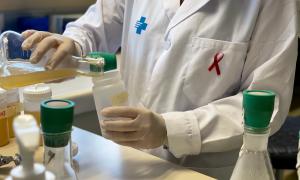Exceptional cases inspiring global solutions against HIV

Today marks World AIDS Day, a crucial occasion highlighting the global fight against HIV, impacting 39 million individuals worldwide. The scientific community persists in its quest for an effective cure strategy to combat this infection.
According to the latest World Health Organization statement, 39 million people worldwide are living with HIV, with 1.3 million new infections reported last year. IrsiCaixa is working on various HIV cure strategies, many of which draw inspiration from unique HIV infection cases. These cases include exceptional elite controllers with no detectable virus in the blood and no disease progression despite no antiretroviral treatment, non-progressing viremics with slow disease progression despite high virus levels, and individuals cured of HIV through a stem cell transplant. Specifically, studying these three profiles allows IrsiCaixa to propose new strategies such as vaccines, molecules, and cellular or genetic therapies against the virus. "These are success stories, and that's why they serve as a reference for those of us dedicated to studying HIV. We seek inspiration in these unique cases to later design strategies applicable to the rest of the population", emphasizes Javier Martínez-Picado, ICREA researcher at IrsiCaixa and associate professor at UVIC-UCC.
Exceptional elite controllers reveal HIV weaknesses
A small number of people infected with HIV spontaneously control the virus, achieving functional cure without any treatment or intervention. These individuals are known as exceptional elite controllers. In 2020, an IrsiCaixa study suggested that two factors allowing them to achieve this control are having a virus with low replicative capacity and possessing an extraordinarily potent immune system. "We believe that the viruses acquired by exceptional elite controllers are less infectious and 'less clever,' exposing their vulnerable areas more, that is, those that can trigger a more potent immune response from the host", notes Julià Blanco, IGTP researcher at IrsiCaixa and associate professor at UVIC-UCC. Currently, Dr. Blanco's team is working on this hypothesis, studying the characteristics of these viruses and the antibodies present in these individuals. "This information is very relevant to us as it will allow us to identify possible weaknesses in the virus and develop vaccines using these key molecules that activate the immune system", he adds.
Halting disease progression by calming the immune system
Unlike exceptional elite controllers who lack detectable virus in the blood, the team has identified a profile of individuals whose viral infection, despite high levels of circulating virus, does not advance and remains controlled: non-progressing viremics. "We have observed that the immune system of these individuals is less activated and sends fewer alert messages, transmitted through molecules called cytokines. This allows their defenses to be more relaxed and not exhausted, protecting them from disease progression", explains Martínez-Picado. "These observations give us clues about the mechanisms that could be accelerating HIV infection progression, and thus, we can design new molecules specifically targeting these pathways", he adds.
Mimicking a stem cell transplant without adverse effects
Only six people in the world have been cured of HIV after a medical intervention. These individuals, after an HIV diagnosis, developed a cancer requiring a stem cell transplant for a cure. After this intervention, any trace of HIV disappeared from their bodies, even without antiretroviral treatment. While these cases are unique, they have opened doors to different lines of research. "The process these individuals had to undergo is not extrapolatable to the rest of people with HIV, but it allows us to see that a cure is possible, as well as study ways to mimic this healing process using less invasive techniques", explains Martínez-Picado. Two options the scientific team is currently considering are gene therapy, based on gene modification, or cellular therapy, which involves creating modified immune cells targeted to eliminate specific targets. "With these two therapies, our goal is to eliminate the virus's targets, i.e., the cells that allow the virus to enter and multiply throughout the body", comments Martínez-Picado.
Curing HIV, a steadfast goal in the fight against the virus
The goal in the fight against HIV is the global eradication of the infection. To achieve this, three fundamental pillars are necessary: prevention, treatment and cure. Efforts thus far have covered the first two pillars. "Currently, we have prevention tools capable of preventing new infections and a treatment that blocks the virus until it becomes undetectable in the blood and, therefore, cannot be transmitted", notes Blanco. "Despite the great advances, we cannot forget the third and final pillar that needs to be built: the cure for HIV. This remains a significant milestone for us, and we are clear that science and research are the only means that will allow us to reach it", emphasizes Martínez-Picado. Achieving this goal would end a chronic, often stigmatized treatment and provide solutions for those who find daily treatment adherence impossible.